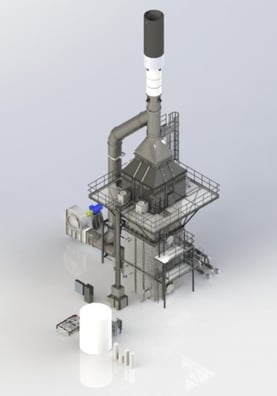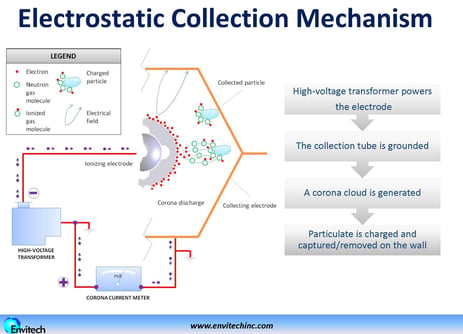
In 2012 Envitech supplied a wet electrostatic precipitator (WESP) to remove submicron particulate and lead particles from a metal processing coating device. Envitech recently completed the start-up of a 2nd WESP for a different coating device at the same facility. Both systems are designed to remove greater than 95% of lead from low inlet concentrations. The inlet lead concentration is similar to that of a secondary lead smelter reverb furnace. Click on the link to read about the secondary lead smelter WESP.
The scope of supply for the new system includes a WESP, instruments, control system, pre-assembled pump skids, interconnect ductwork, dampers, stack, access platforms, and make-up water treatment system. The WESP is a hexagonal tube, upflow design. The gas enters the bottom of the WESP and passes through the conditioning section to ensure the gas is fully saturated and evenly distributed to maximize collection efficiency.
After the conditioning section, the gas enters the collection section. Electrostatic forces remove particles contained in the gas stream (see graphic below). The collector consists of grounded collector tubes and high voltage discharge electrodes. A voltage is applied to the discharge electrodes to both charge the particles and create a powerful electric field. The voltage on the discharge electrodes instigates a corona discharge of electrons from disks on the electrodes. The electrons move from the discharge disk to the collector tubes. Some of the electrons intercept particles in the gas stream which charges the particles. Once charged, particles migrate across the gas stream towards the grounded collector tubes. The particles are intermittently flushed with water from a spray header above the collector. Collected particulate containing lead fall by gravity from the tube walls into the WESP sump.
 The outlet section is the last section and contains an entrainment separator to collect water drops that were entrained in the gas stream during the collector wash cycle. It also houses a support structure for the high voltage electrodes and wash water spray header.
The outlet section is the last section and contains an entrainment separator to collect water drops that were entrained in the gas stream during the collector wash cycle. It also houses a support structure for the high voltage electrodes and wash water spray header.
The system has a unique water and wastewater treatment system that mitigates the need for a hazardous liquid blowdown. An upstream water treatment system conditions the city water used to makeup losses associated with evaporation. The recirculation water to the system is filtered to remove hazardous particulate as a solid, greatly reducing the operating cost of disposal. The collection of the hazardous waste as a solid substantially reduced the facility hazardous disposal costs.
The facility reports high reliability and uptime with little intervention required to maintain operation and performance. The electrodes are rigid mast and firmly held in placed after alignment during start-up. Less than 2% of the electrodes have been replaced in seven years of operation. The WESP is designed to meet the below parameters:
- Inlet flow rate - 35,000 acfm
- Inlet temperature – 140°F
- Lead particulate performance guarantee – greater than 95% removal
Click on the link below to download a case study on this application.


